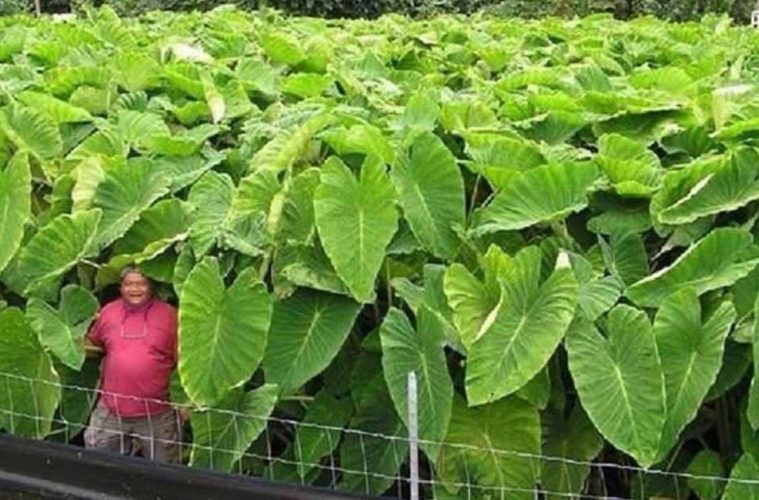On Saturday, January 27th Waimea Valley will host a free workshop “Kalo Basics” from 9 a.m. – noon. The workshop will be covering basic kalo cultivation, pests and disease, as well as kalo variety identi cation. For more information visit www.waimeavalley.net
“Taro” refers to a number of edible aroids in the plant family Araceae, within the four genera of Colocasia, Alocasia, Cyrtosperma, and Xanthosoma. When we talk about Hawaiian taro or kalo we are talking about the genera Colocasia, which many varieties of kalo arise. Taro is one of the oldest cultivated crops in the world. Today, taro is still consumed widely but on a much smaller scale due to the industrial rise and consumption of wheat, rice, corn and potato.
Kalo was the staff of life for the Hawaiian culture and was revered as the “older brother” of the rst Hawaiian people. Among other starches that were consumed kalo was king; from table taro to baby food kalo was eaten on a daily basis. A key starchy staple in Hawai‘i, the kalo plant is versatile not only in the way that it was used but in the way that it is able to be grown. From the uplands to near the sea, kalo was grown on a large scale for everyday use. One thing that I hear a lot from interested gardeners is “I would grow kalo, but I don’t have any streams or running water near my place,” this is a common misconception that kalo can only be grown in a wet culture setting.
In ancient times, owing water was sacred and was mostly utilized for drinking water, cleanliness, and kalo production. The cultivation of kalo was typically done in and near streams, and the amount of ‘ai (food) and the health of the ahupua‘a (land division) persisted within these wai (water). As the budding populations grew and nourished and the lush owing waters were farmed people needed to utilize more arid, non- flooded areas. Horticultural skills developed to continue growing food in these non- flooded areas or mala (garden), and non- flooded culture remains the primary method of kalo production throughout the Pacific today. A mala style garden makes the most sense for a backyard kalo grower, this type of garden allows you to grow kalo on a small scale and also utilize modern technologies such as simple soil preparation, fertilizer application, drip irrigation with timers, and integrated pest management.
Hawaii’s volcanic islands have a more diverse soil series than most places in the world, so it is hard to say that there is a right way to grow kalo in any one spot. However, a very basic framework for starting a mala is:
Plan your garden site: Choose a site that receives sunlight throughout the day. Aim for a location with good air ow (not surrounded by large trees and bushes). Allow simple access to the garden as well as a water source. Soil tests are not absolutely crucial, but will give you a good idea of what is there and what can be improved. A basic soil sample can be processed at the Uni- versity of Hawaii Soils Lab, by visiting this link: https://www.ctahr.hawaii.edu/oc/freepubs/pdf/SCM-9.pdf
Cultivate the area: Use a tiller or an o’o (digging stick) to prepare a 6-inch deep bed. Remove all weeds, add a general organic or inorganic fertilizer, (10-10-10, sh bone meal, bone meal, chicken manure etc.) add compost (well broken down, mature), and water in and let it sit for a couple days before planting. Take notice of any pests you encounter while watering and tending your garden (white y, mealy bug, aphids, etc.) and control accordingly (typically a soapy water solution of 10 parts water: 1 part soap) will do the trick. In an ideal situation you will minimize the build-up of pests and disease by rotating your kalo through several garden plots.
Find a source of water: If you live in an area that will provide around 80-100 inches of rainfall per year your crop will have sufficient water. If you are gardening outside of this annual rainfall, hand watering or an automated drip irrigation system will be necessary in keeping your crop hydrated. Hand watering serves as a great opportunity to be amongst the plants and keep your eyes on taro diseases, pests, and nutrient de ciencies.
Identify the best varieties of kalo for your area: Waimea Valley on Oahu’s North Shore is one place that provides expertise in gardening Hawaiian and non-Hawaiian taro varieties and once a year serves as a community distribution center for kalo huli. Kupunakalo.com also provides a great resource for all around kalo culture and variety selection.
Best practices
Gardening is hard work. Keeping yourself safe and able to work the next day is crucial for long term food production and quality of life. Practice safe gardening by keeping your body weight centered over your feet (not bending over while lifting or pulling), staying hydrated, and working only within your means. Your only goal in the garden is to be in the garden again the next day.
Resources
Many passionate people grow kalo on a small and large scale. Many horticulturists and gardeners have paved the way for us. Look to these “knowledge banks.” If you do not have access to one of these wonderful people or places, there are also some very informative books and publications available:
• College of Tropical Agriculture and Human Resources, University of Hawaii. Taro Mauka to Makai: A Taro Production Guide and Business Guide for Hawai‘i Growers, 2008. UH-CTAHR.
• E.S. Handy, E.G. Handy, M.K. Pukui. Native Planters in Old Hawaii: Their Life, Lore, and Environment, Bernice P. Bishop Museum Bulletin 233. 1991. Bishop Museum Press
• KupunaKalo.com
We do not inherit the earth from our ancestors; we are borrowing it from our children.



